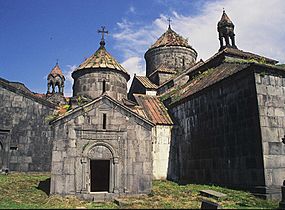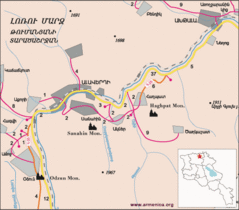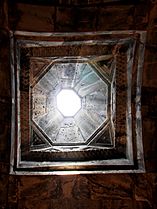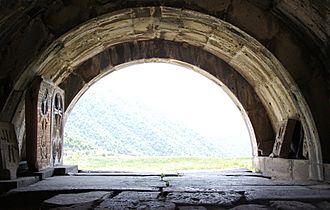Haghpat Monastery facts for kids
Quick facts for kids Haghpat MonasteryՀաղպատավանք |
|
|---|---|

The Church of Surp Nshan at Haghpat Monastery
|
|
| Religion | |
| Affiliation | Armenian Apostolic Church |
| Location | |
| Location | Haghpat, Lori Province, Armenia |
| Architecture | |
| Architectural style | Armenian |
| Groundbreaking | 10th century |
| Official name: Monasteries of Haghpat and Sanahin | |
| Type | Cultural |
| Criteria | ii, iv |
| Designated | 1996 (20th session) |
| Reference no. | 777 |
| UNESCO Region | Europe and North America |
Haghpat Monastery, also known as Haghpatavank (Armenian: Հաղպատավանք), is a medieval monastery complex in Haghpat, Armenia.
The monastery
The monastery was founded by Queen Khosrovanuysh, wife of the Bagratid king Ashot III, probably in 976. The nearby monastery at Sanahin was built around the same time.
The largest church in the complex, the Cathedral of Surb Nishan, probably begun in 976, was completed in 991 by king Smbat. It is a typical example of tenth century Armenian architecture, its central dome rests on the four imposing pillars of the lateral walls. The Armenian Prince Khutulukhaga, is depicted in the south transept (a transversal nave intersecting the main nave). The sons of the church's founder, Princes Smbat and Kurike, are shown with Queen Khosravanuysh in a bas-relieff. Excepet from one or two minor restorations carried out in the eleventh and twelfth centuries, the church is preserved its original character.
There are several other structures at the site as well. There is the small domed Church of Sourb Grigor (St. Gregory ) from 1005. Two side chapels were added to the original church; the larger one built in the beginning of the 13th century and the smaller, known as "Hamazasp House", built in 1257. In 1245. Other 13th century additions include the chapel of Sourb Astvatsatsin, the scriptorium, and a large refectory which is outside the monastery limits.
There are also a number of splendid khachkars (cross-stones) of the 11th-13th centuries standing on the territory of the monastery.
The monastery has been damaged many times. Sometime around 1130, an earthquake destroyed parts of Haghpat Monastery and it was not restored until fifty years later. It also suffered numerous attacks by armed forces in the many centuries of its existence and from a major earthquake in 1988. But much of the complex is still intact today without substantial alterations.
Today the area is an popular tourist site.
UNESCO World Heritage Site
Described as a "masterpiece of religious architecture and a major center of learning in the Middle Ages", Haghpat monastery, together with Sanahin monastery, was placed on UNESCO's World Heritage List in 1996.
The monasteries at Haghpat and Sanahin were chosen as UNESCO World Heritage Sites because:
The two monastic complexes represent the highest flowering of Armenian religious architecture, with unique style developed from a mix of elements of Byzantine ecclesiastical architecture and the traditional vernacular architecture of the Caucasian region.
Gallery
-
The belltower at Haghpat Monastery
-
Haghpat, looking from inside out; note cross stones or khachkar's on left and right
-
Cross stones or khachkars at Haghpat Monastery, Armenia
See also
 In Spanish: Monasterio de Haghpat para niños
In Spanish: Monasterio de Haghpat para niños











